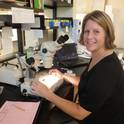Cephalopods of the northern Gulf of Mexico are widely distributed and provide an important food source for a variety of marine animals. Sperm whales are year-round residents in the northern Gulf of Mexico. Prey availability has been proposed as an explanation for this non-migratory whale population. To examine this explanation, a short pilot cruise was conducted during the summer of 2009 to test equipment and to obtain preliminary observations. Then the 3-month Sperm Whale Acoustic Prey Study (SWAPS) was conducted during the winter/spring of 2010 to sample the mid-water pelagic community for possible prey of sperm whales. It also compared sperm whale distribution and prey composition across habitats of the northern Gulf of Mexico. This paper focuses on the cephalopod diversity within the mid-water pelagic community and assesses potential prey of the endangered sperm whales.
Article
Cephalopods in the potential prey field of sperm whales (Physeter macrocephalus) in the northern Gulf of Mexico.
USF St. Petersburg campus Faculty Publications
Document Type
Article
Publication Date
2013
Disciplines
Abstract
Language
en_US
Publisher
Taylor and Francis
Creative Commons License
Creative Commons Attribution-Noncommercial-No Derivative Works 4.0
Citation Information
Judkins, H.L., Arbuckle, S., Vecchione, M., Garrison, L., & Martinez, A. (2013). Cephalopods in the potential prey field of sperm whales (Physeter macrocephalus) in the northern Gulf of Mexico. Journal of Natural History. DOI: 10.1080/00222933.2013.802045

Abstract only. Full-text article is available only through licensed access provided by the publisher. Published in Journal of Natural History. DOI: 10.1080/00222933.2013.802045 Members of the USF System may access the full-text of the article through the authenticated link provided.